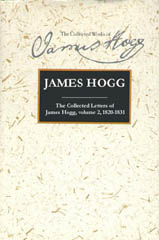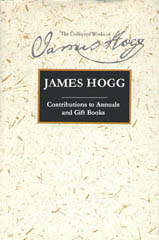Janette Currie
Hogg, Collected
First begun in 1995 to provide a new, scholarly edition of the collected works of James Hogg in more than a hundred years, the Stirling/South Carolina Research Edition is only a little over ten years old itself, yet it is more than half-way towards achieving its aims. The appearance of these two most recent publications now takes the number of volumes to eighteen, within another sixteen to go.
Writing in the Scottish Literary Journal in 1996, following the appearance of the first three volumes in the Stirling/South Carolina Research Edition, Edwin Morgan said, ‘it has taken a long time for Hogg to be recognised as one of the most notable Scottish writers, and it can fairly be said that the process of getting him into full and clear focus is still far from complete. That process is immeasurably helped by the provision of proper and unbowdlerised texts, in many cases for the first time, and in this the ongoing Collected Works will be a milestone.’
Like Scott, Hogg was a collector of ballads, echoes of which can be found in his own poems, and like Burns, he wrote songs, which ‘taught the wandering wind to sing.’ But unlike Burns, who was no ‘Heav’n-taught Ploughman’ and who did receive an education, Hogg was largely untaught. In the introduction to epic poem The Queen’s Wake, published in 1813, Hogg’s publisher took great pains to describe him as, ‘a common shepherd, bred among the mountains of Ettrick Forest, who went to service when only seven years of age, and since that period never received an education whatever.’ Despite his prodigious literary output, and his admirers, who included Byron, Wordsworth, De Quincey, Scott, Galt and the Brontës, Hogg’s lack of education was regarded by many during his lifetime as too great an impediment to qualify him as a writer of genius. (Nor was his reputation much helped by his irritating portrayal as the ‘boozing buffoon’ of a Shepherd by Christopher North in ‘Noctes Ambrosianae’ in Blackwood’s Edinburgh Magazine.) This prejudice was greatly reinforced in the years immediately following Hogg’s death in 1835, when posthumous editions of the work of this uncouth literary farmer began to appear in expurgated collections, with all that was perceived as indelicate expunged. Because these already sanitised editions were further bowdlerised by the Rev Thomas Thomson in the 1860s, in the case of some works, what came down to us were unsatisfactory texts at several removes from the originals. For more than a century after his death, Hogg was remembered chiefly for one or two of his poems of the supernatural and for his ‘one really remarkable achievement’, The Private Memoirs and Confessions of a Justified Sinner, though it too had been subject to assaults from various editors including the removal of infelicities of language, bowdlerisation, the excision of theological material, as well as damage to the structure of the narrative.
It was not until the 1940s that an interest in Hogg was revived when the writer André Gide discovered The Private Memoirs and wrote a critical introduction for a French edition of this work, declaring Hogg to be a writer of genius. Although Hogg’s writings have been receiving growing scholarly attention in the past twenty years or so, and during the same period a few of his works have been issued in accurate texts based on the early printed editions, the real turning-point has been the appearance of the Stirling/South Carolina Research Edition of the Collected Works which is greatly facilitating this wider process of rediscovery and assisting the revaluation of Hogg as a major writer of the British Romantic period.
Alongside the publication of Hogg’s literary works, his letters are also being brought together in a systematic collection for the first time. This is being done under the direction of Dr Gillian Hughes, who has edited other works by Hogg in the Stirling/South Carolina Research Edition and who is also preparing a life of this writer of genius, to be published in 2007.
The first volume of letters for the years 1800-1819, when Hogg had already begun to write for Blackwood’s, appeared in 2004, the second covers the period 1820-1831 when Hogg’s reputation as a celebrity writer was being established, and it was during this time that he was to publish his unique The Private Memoirs. In her introduction to this volume, Gillian Hughes does remind the reader that, ‘until comparatively recently Hogg has not been generally regarded as a major author, whose entire correspondence is worthy of serious attention.’ She adds, ‘the time has come to take Hogg seriously as a major Romanticist and as one of the greatest of Scotland’s writers’ and that ‘with the appearance of his letters his reputation will be enhanced.’ These letters, with textual notes and indispensable commentary, are genuinely revealing in many ways: they contain a wealth of information about Hogg the professional literary man, engaged in his writing and in business with his publishers during his ‘Blackwood Years’, as well as Hogg the charming suitor in his communications with his wife-to-be. (As Hogg was to marry Margaret Phillips at the end of April 1820, this naturally saw ‘the effective termination of a regular correspondence’. It would not be until his three-month visit to London during 1832 that a more extensive correspondence with his wife would be resumed. Letters for that period will appear in the third and final volume of letters, which is to appear in 2009.)
In addition to revealing fascinating personal information about Hogg as writer, farmer, husband and family man, these letters also provide a huge amount of detail about the publishing world of the times, particularly in relation to periodical literature which abounded throughout that period.
Contributions to Annuals and Gift-Books brings together many poems, songs, short prose pieces that Hogg wrote for these publications designed as Christmas and New Year presents. The literary phenomenon of the gift-book was far from new, it had existed as early as the sixteenth century, though it did not develop as a commercial enterprise until the early 1820s when it combined literary content of verses or short prose pieces with engraved plates to produce what became the annual. Early examples of this kind of publication included contributions from such writers as John Clare, Coleridge, Scott, Galt and Mary Shelley, and later from Tennyson, Ruskin and Dickens. Though a highly popular genre, annuals were a relatively short-lived phenomenon – production costs were always high and competition for sales and readers was always fierce given the prolific number of annuals in the market. Initially received as being ‘beyond criticism’, the annuals soon met with hostility from the critics and from the established literary magazines. W.M. Thackeray thought them ‘detrimental to literature’ and while being seen as ‘good for the publishing industry because they generated sales’, they were viewed as ‘bad for literature because they encouraged mediocre writing and bad editing.’ Hogg as ‘a professional writer grasped the important shift that [periodical] literature was taking, and did not display the contempt for annuals of many of his contemporaries but openly accepted the new and wider opportunities that the annuals gave to him to display his writing talents.’ Accompanied by helpful, scholarly introductory and textual notes, the Contributions to Annuals and Gift-Books contains about seventy works by Hogg, some never seen since first publication in the 1820s.
A truly monumental project, the Stirling/South Carolina Research Edition of the Collected Works of James Hogg, like the Edinburgh Edition of the Waverley Novels, is a major Scottish publishing event that is worth shouting about. Both these projects will put these two great nineteenth-century Scottish writers back on the literary map where they belong. Some of the Hogg volumes in this Research Edition have also been issued in paperback by Edinburgh University Press.
The Collected Letters of James Hogg, Volume 2, 1820-1831, edited by Gillian Hughes, with Douglas S. Mack, Robin MacLachlan, and Elaine Petrie. Edinburgh University Press (ISBN O74861673X HBK £40); James Hogg, Contributions to Annuals and Gift-Books, edited by Janette Currie and Gillian Hughes (ISBN 074861527X HBK £40).
© Michael Lister 2006



Comments